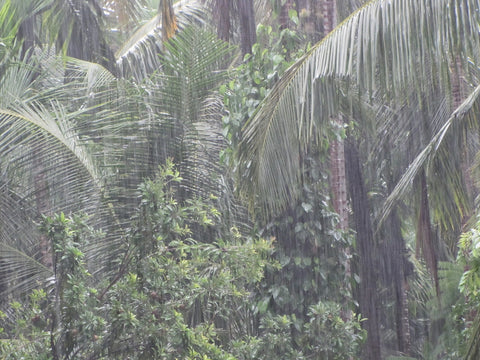Coconut Harvest April 20 2014 1 Comment
The sight of the tall, imposing coconut palms, swaying gracefully, indeed soothes and delights the beholder. We take the sight so much for granted, so it is hard to imagine the excitement and awe that it can generate in someone who has never seen coconut trees. Of course in today’s age of virtual travelling, it would not surprise many, but in the words of Fanny Parkes, the English woman who lived and travelled in India between 1822 and 1846, “....surrounded by high trees; among these, the coconut, to an English eye, was the most remarkable”.
An aerial view of a coconut plantation
Well, for us, the sight of the coconut tree climber at work, is still an exciting, awe-inspiring event. Every 3 months, we need to harvest the coconuts from the 100 odd trees that dot our farm. So, enter Lakshmana, the 23 year old, tall lanky youth who lives in the little village of Heggade about 7 kms beyond Chitrapur.

Family circumstances and the lack of a local secondary school cut short his aspirations to study beyond class IV. He took to tree-climbing to supplement the family income and is a member of this fast diminishing tribe of dare-devils.
He zips in on his bike at 8.30 am sharp. In 15 minutes, he has changed into his shorts, sharpened his sickle on the stone next to the tap and readied his gear. His climbing gear is nothing but 2 loops of plastic sacking and a rope around his waist which has a special hook for hanging his sickle. One loop of sacking goes around his feet and one goes around his hands and there he is... like a monkey hauling himself up....up....up... till you, standing safely on the ground, start to feel dizzy, just looking at him perched high up, close to the crown of the tree.

Clutching the tree with his legs and one hand, the other hand reaches behind and grabs the sickle. Slashing away the dead-wood, dried fronds, panicles, totally unmindful of the dust that goes into the eyes and leaves even us on the ground blinking and red-eyed, he reaches out to feel the coconut from a large bunch. A slight twist of his wrist and he knows whether it is ready for harvest or not. Out comes the sickle again, a single slash and down comes a giant bunch of coconuts decimating everything in its path. The bunch lands with a resounding thud and the nuts break free and bounce around in a radius of almost 10 metres.
Ouch! My delicately grown garlic greens and little marigolds. I am just looking around to assess the ‘damage’ and he has already slithered down and is ready to climb the next tree. Within 20 minutes, he has completed 5 trees that is an astounding 4 minutes per tree. After about an hour and a half, he looks exhausted. Drenched in sweat, he takes a small break. He has kept a bunch of tender coconuts aside and slicing them open with lightening speed, he hands one to us and gulps down one himself. And he is ready for some more climbing. Over a span of 3 to 4 days, all the trees have been harvested. Picking the scattered coconuts and carrying them to the storage shed is a mammoth task. Our farm hand Manjunath and Lakshmana together manage quite well and by evening the harvest is piled high.

The harvest with the dehusker blades - one in the foreground and one on the right
Many machines have been designed for coconut shelling, but these two prefer the old blade-in-the-wood contraption. This is a heavy block of wood with a sharp pointed blade sticking vertically upwards. The coconut is impaled on it with a swift stroke, a crunching turn and one third of the husk is off. Twice more and the de-husked coconut is tossed onto a steadily growing pile and the husk is tossed onto another pile.

The husks; when dried provide fuel for heating our bath water in the old fashioned copper 'Bhaan'

Pile of de-husked coconuts
This time Lakshmana is in a hurry to complete the de-husking and brings in two of his friends to help him. The three of them de-husk 1200 coconuts in 3 hours making it a 100 coconuts each in an hour – amazing speed, amazing people. By afternoon, the de-husked coconuts are all packed into sacks and lined up next to the weighing machine. Lakshmana whips out his cell phone, arranges for the tempo and is ready with his cell phone calculator to add up the weight of all the bags. Swiftly the sacks are weighed and loaded into the tempo and then Lakshmana hops onto his bike with his two friends riding pillion behind him zooms off. He has to begin work in yet another plantation tomorrow.
Rain in a coconut plantation - a lovely sight
The hornbill's favorite perch atop a coconut tree





Comments
Suvarna Hattangadi on October 27 2014 at 06:08PM
What a sight! How I wish I was there to watch lanky Lakshmana slither up the coconut palm.
I remember when we visited Shirali with our children, Neil and Jona, in the 90’s, the verdant paddy fields, with tall Arecanut palms, and coconut palms, swaying their graceful fronds.
At that time, we visited my cousin Sujata and Rammohan Padukone, in Shirani. Their son Gourish is a vet, you may know them already.
Gourish offered us fresh coconut and gave us a tour of his property and milking cows.
The lush surroundings made a lasting impression on my heart.
How beautiful is our Karnataka!
Thanks to you that you are tracing back to where our ancestors came from, and living the life that they had,
working the same land, but with modern amenities, like computers and electricity.